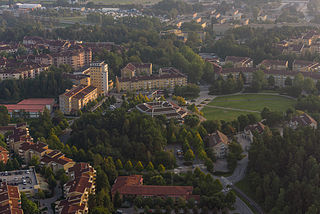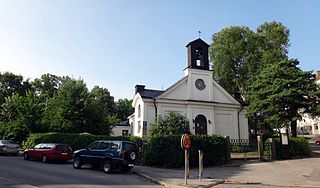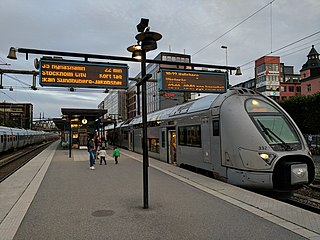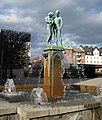
Sundbyberg Municipality is a municipality in Stockholm County in east central Sweden, just north of the capital Stockholm. Sundbyberg is wholly within the Stockholm urban area and has a 100% urban population.

The Stockholm Metro is a rapid transit system in Stockholm, the capital city of Sweden. Its first line opened in 1950 as the first metro line in the Nordic countries. Today, the system consists of three lines and 100 stations, of which 47 are underground and 53 above ground. The system is owned by Region Stockholm via SL, the public transport authority for Stockholm County. It is the only metro system in Sweden.
Flemingsberg is a southern suburb of Stockholm, Sweden that is located in Huddinge Municipality in the south-western part of the contiguous Stockholm urban area.

Storstockholms Lokaltrafik known as SL, is the public transport organisation responsible for managing land-based public transport in Stockholm County, Sweden. SL oversees a network that includes the Stockholm Metro, Pendeltåg commuter trains, buses, trams, local rail, and some ferry services.

Kymlinge is an area of Sundbyberg Municipality, Stockholm County, Sweden. It is mostly a recreational park, part of which is a nature reserve (Igelbäcken).

Tvärbanan is a light-rail line in Stockholm, Sweden. Its name translates literally to The transverse line, as it operates crosswise to the otherwise radial metro and commuter rail lines of Stockholm. It links together several transit lines through its connections with the southern, western and northern subway branches of the Stockholm Metro (Tunnelbana) as well as three branches of the Stockholm commuter rail (Pendeltåg). The possibility to travel between southern, western and northern greater Stockholm without having to enter the city centre significantly reduces the number of transit passengers, also reducing the number of trains having to pass through the Old Town bottleneck during peak hours. Near Liljeholmen the track is shared with freight traffic for a short section, this being the only place in Sweden where freight traffic and trams share the same track.

Nockebybanan is a tram line between Nockeby and Alvik in the western suburbs of Stockholm, Sweden. The 5.6 kilometers (3.5 mi) long line is part of the Storstockholms Lokaltrafik public transport network, and connects with the Stockholm metro and Tvärbanan tram at Alvik metro station. The Nockebybanan, also known as line 12, is operated by Arriva.

Stockholm commuter rail is the commuter rail system in Stockholm County, Sweden. The system is an important part of the public transport in Stockholm, and is controlled by Storstockholms Lokaltrafik. The tracks are state-owned and administered by the Swedish Transport Administration, while the operation of the Stockholm commuter rail services itself has been contracted to SJ AB since March 2024.

Transport in Stockholm consists of roads, buses, metro, commuter rail, Inter-city rail, regional rail, light rail, tram, commuter ferry and an archipelago boat operation in Stockholm County, Sweden. The bus and rail is organized by Storstockholms Lokaltrafik, SL, which is owned by the Stockholm County Council. Tickets for all SL services can be purchased most easily in the SL app. For single tickets, just tap a credit card against the turnstiles and on buses. A single ticket is valid for 75 minutes, costs 39 SEK in 2023. The operation and maintenance of the public transport systems are delegated by SL to several contractors. The archipelago boat traffic is handled by Waxholmsbolaget.

Lidingöbanan is a light-rail line in Stockholm, Sweden, between Ropsten and Gåshaga brygga, serving the southern half of Lidingö island.

Rissne is a neighborhood in the western part of Sundbyberg Municipality, Stockholm, Sweden. It has about 7500 inhabitants and borders to Stora Ursvik in the north, Duvbo and Hallonbergen in the east, and in the west and south to Bromsten, the latter one within Västerort in Stockholm Municipality. The area belonged to what used to be Spånga municipality until its dissolution in 1949, when it for example together with Duvbo was transferred to Sundbybergs stad. The name comes from Risö, which was the name that the Vikings used. The Svea Artillery Regiment had its camp there until 1960. An apartment block was built 1982 to 1988. The street names in the area hints to the site's military history. and on the many relics contained in Rissne.

Sundbybergs centrum is a metro station, located in Sundbyberg Municipality, approximately 8 km (5.0 mi) from the centre of Stockholm. It opened on 19 August 1985 as part of the extension to between Västra skogen and Rinkeby. The metro station is connected to a stop on Tvärbanan with the same name, as well as to Sundbyberg railway station served by the Stockholm commuter rail and long-distance trains.

Alvik metro station is a station on the Green line of the Stockholm metro, and on the Tvärbanan and Nockebybanan lines of Stockholm tramways. It is located on the border between the districts of Traneberg and Alvik, which are part of the borough of Bromma in the west of the city of Stockholm. The station is one of the intermediate termini along the northern section of the Green line, with line 18 trains normally terminating, and is also the terminus of the Nockebybanan.

The Stockholm tramway network forms part of the public transport system in Stockholm, the capital city of Sweden.

Lilla Alby is a district in the southern corner of Sundbyberg Municipality, Sweden. It lies southwest of the railway Mälaren Line. It is separated from Bromma by bay Bällstaviken to the southwest, and borders Solna Municipality to the south and east, and Centrala Sundbyberg to the north. Lilla Alby has 4,235 citizens.
Stora Ursvik is a district in Sundbyberg Municipality with 2306 inhabitants, and a suburb in the Stockholm metropolitan area. An unbuilt corner of the district is located in Stockholm Municipality. This residential area is under construction, with an estimated completion in 2026. The first people moved in in 2007. Before that it was farmland owned by the Oxenstierna family, then from the beginning of the 20th century by the Swedish military until 2005. It is connected to Lilla Ursvik to the east and the uninhabited Kymlinge to the north. It is separated by motorways from Rinkeby to the west and Rissne to the south. Two tram stations, on the Tvärbanan Kista line, are planned in the west of the district. The building plan for the district has low buildings in the north and east, and higher buildings in the south and west.

Solna is a station in Solna Municipality in Stockholm for commuter trains and the Tvärbanan light rail. The lines J40, J41, J42 (Märsta-Nynäshamn) and L30 stop here, as well as ten bus lines. The commuter train station opened in 1895, but was moved a 100 meters in 1903 and moved again in 1911, when the tunnel through the hill Hagalundsberget to the south was completed. In 1955 the name of the station was changed from "Hagalund" to "Solna". The northern entrance is located at a bridge connecting the Arenastaden and Frösunda areas of the Järva district. Arenastaden is home to the Strawberry Arena and the Westfield Mall of Scandinavia. The southern entrance is located between the districts Hagalund and Råsunda. In 2014 the Tvärbanan line was extended to the south entrance, with a stop called Solna station. A metro station, named "Arenastaden", on a new extension from Odenplan, is planned to have its southern entrance next to the Tvärbanan station, on the other side from the railway station entrance, while the northern exit will be just south of the Arenastaden area. On an average day, 20 900 journeys are done by commuter train from Solna station, 5 200 by Tvärbanan and 4 600 by bus.

Mariehäll is a suburb of Stockholm and a district in the north-east of the Bromma borough of Stockholm Municipality. In 2019, Mariehäll had 9,024 inhabitants.

Årstaberg is a station on Stockholm's commuter rail network, situated in the on the border between the Liljeholmen and Årsta districts in the south of Stockholm Municipality. The station has a central platform with two tracks serving commuter trains, along with additional tracks for passing trains that do not stop at the station. Årstaberg Station also features a stop on the Tvärbanan light rail line.

Sundbyberg is a railway station in central Sundbyberg, 6.4 kilometers from Stockholm Central Station. It opened in 1876 as part of the Mälaren Line. The station serves both Stockholm commuter rail trains around Stockholm County, and regional trains operated by SJ to Västerås and Gothenburg. It is located directly adjacent to the border with Solna Municipality.



























